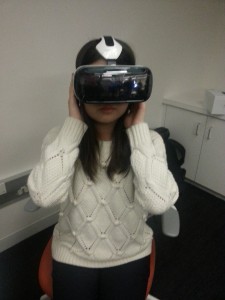Assignment 1 – VR Experience
by Archive User
- January 16
- in
Michelle Kim
On the first day of class, January 14, my classmates and I were given the opportunity to test out four VR devices: the Samsung Gear, Oculus DK1, Oculus DK2, and Google Cardboard. All four experiences were something remarkable. There was such a strong sense of realism that I actually felt as if I was in each of the stories I viewed. When I left the VR world in each device, there was a brief feeling of confusion and surprise. But of course, there were differences in each experience.

Samsung VR. Photo taken by Claire Dunderman.
Let's start off with the Samsung Gear. This was the first device I tried. Sturdy and with a sleek all-white design, this device was my favorite of the four. Not only did it look like and work like what it's worth, but it was also the device that made me feel physically present in the story the most. I felt a strong sense of realism, and the quality of the story I saw was remarkably HD. As soon as I put the head set on and played what was offered, "Cirque Du Soleil," my reaction was, "Whoa, this is crazy." I could look around 360 degrees at the theater that the performance took place, and the performers reacted when I looked at them. The detail was so real and crystal clear that it felt uncanny. I believe that it was the HD detail in the story that really contributed to the realism aspect.
I could see that the people in my test group felt the same way. As soon as group members Max and Claire put on the headset, their mouths dropped and they said the same things I did, "Wow, this is weird." Speaking to them afterwards, we all agreed that VR would change the world as we know it. If we had the chance to, we would be engrossed in VR to the point that we would choose it over social interaction.
The Oculus DK1 and DK2 worked in much of the same way that the Samsung Gear did. The only difference was that the DK1 and DK2 weren't as sleek in design as the Samsung Gear was, which is not a big fault in itself as the devices still worked like a charm. The DK1 allowed me to experience the "Star Trek" board while the DK2 had me venturing through the world of Tolkien's "Lord of the Rings". While each experience was great, I thought that compared to the Samsung Gear, both lacked a bit in the realistic, immersive area.
While I still cannot pinpoint what the reason was, I feel like the quality of the story's graphics added to this. Without speaking about the uncanny valley, the more realistic something is, yes it will look fake to humans, but when the graphics are videos of actual people, then that is different. I think that was why Google Cardboard (showed a fast street video) and Samsung Gear felt real to me the most. And speaking of Google Cardboard, this was my least favorite of the four. I found the material and design to be very flimsy, and the story moved too quickly. This lessened my liking for the device.
However when comparing the DK1 and DK2, the DK2 worked the best for me. Most likely because it is a later model, the DK2 offered the ability to lean forward. This gave a greater sense of realism. Overall, when looking at wired and wireless VR devices, I liked the wireless versions more. I felt like the wireless versions added to the feeling of realism, as the wire on the wired devices broke the fantasy (if you bump into them while turning your head).
For my suggestion of an Oculus project to test, I found a project called SightLine: The Chair for the DK2. The link to the project is http://sightlinevr.com/ This can also be found on the Oculus Rift site.
COMMENTS